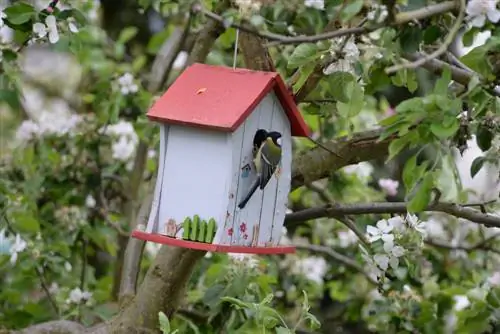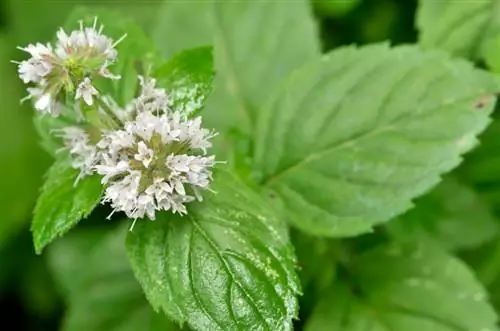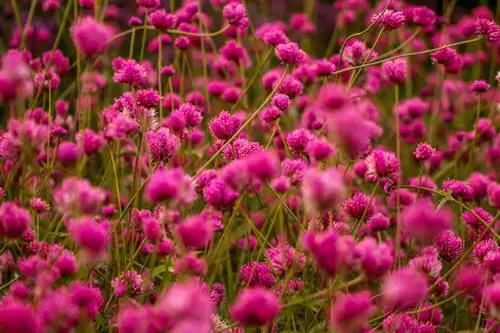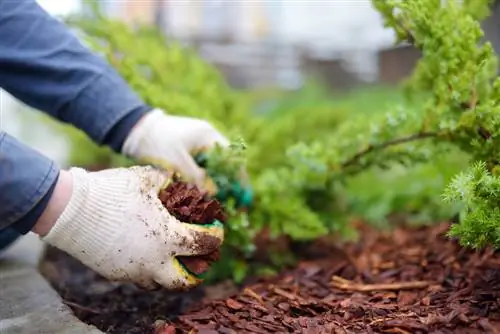- Author admin [email protected].
- Public 2023-12-16 16:46.
- Last modified 2025-06-01 06:02.
Which feathered friend you grant access to the self-made nesting box depends on the diameter of the entry opening. Only those bird species whose bodies fit through the hatch are allowed entry. Bird house builders can use a table to find out the correct nest box hole size for 20 species of birds. Practical tips & tricks reveal how you can build a fully booked home for tits, starlings and other birdies yourself.
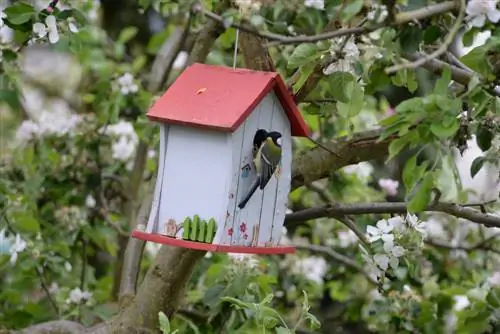
What hole size do nesting boxes need for different bird species?
The correct hole size for nesting boxes varies depending on the bird species: blue tits need 26-28 mm, sparrows 32-34 mm and starlings 45-50 mm. A nesting box with a wide slot as an entry opening is suitable for semi-cave nesters such as blackbirds, wrens and robins. There should also be at least four 3-4mm bottom holes for ventilation and dehumidification.
- Correct nest box hole sizes for common bird species: tits 26-28 mm, sparrows 32-34 mm, starlings 45-50 mm.
- Blackbirds, wrens and robins are semi-cave nesters and want a nesting box with a wide slot as an entry opening.
- Nesting boxes for each bird species have at least 4 bottom holes with a diameter of 3-4 mm for ventilation and dehumidification.
Building a nesting box - hole size table
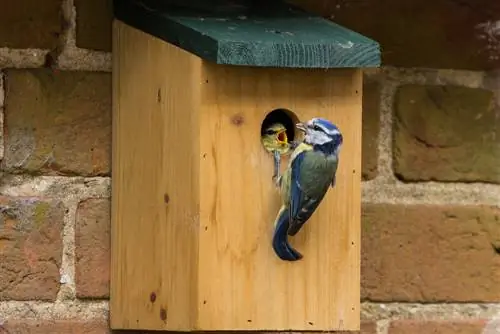
Blue tits need a hole size of 26-28 mm
Nature-oriented hobby gardeners are open to the great housing shortage in the local bird world and are building a hospitable nesting box. The type of bird that comes here and starts a family depends on the diameter of the entrance opening. You can see which hole size is suitable for which bird in the following table:
| bird species | Hole size Ø mm |
|---|---|
| Blue Tit | 26-28 |
| Jackdaw | 85 |
| Field Sparrow | 30×45 (oval) |
| Redstart | 47 |
| Goosander | 150 |
| House Sparrow/Sparrow | 32-34 |
| crested tit | 26-28 |
| Hohltaube | 85 |
| Nuthatch | 32-47 |
| Great Tit | 32-34 |
| Swift | 32×64 (oval) |
| Barn Owl | 200×150 (oval) |
| Woodpecker | 45-50 |
| Barred Owl | 45-50 |
| Little Owl | 80 |
| Pied Flycatcher | 32-34 |
| Kestrel | 160 long slot |
| Tawny Owl | 120 |
| Hoopoe | 70 |
| Screwed Owl | 65-70 |
In addition to the entrance opening, please drill 4 holes in the floor for ventilation and humidification, each with a diameter of 3-4 mm.
Excursus
Blackbird, wren and robin nest in the half-cave box
Not all garden birds want a home with a loophole. Blackbirds, wrens and robins prefer to breed in niches and crevices. Because the three native bird species do not like to squeeze through a narrow entrance, they are left behind in the classic cavity nesting box. Ambitious bird lovers don't need to be told twice and build a semi-cave nesting box. This simplifies construction work because there is no need for precise measurements and drilling for the right entrance gate. The picture below shows the simple construction of a half-open nesting box for blackbirds, wrens or robins:
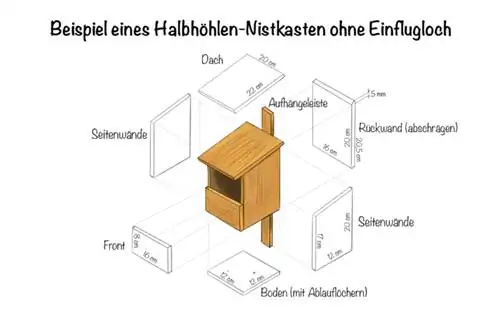
Build your own nesting box - table of dimensions and hanging height
The right hole size does not make a turnkey birdhouse. To ensure that your feathered tenants can set up a comfortable nursery behind the entrance hole, species-appropriate dimensions are also important. To protect the small bird family from cats, martens and other predators, the correct hanging height also plays an important role. The following table summarizes the ideal data for our top 20 native bird species:
| bird species | Internal dimensions WxDxH mm | Hanging height |
|---|---|---|
| Blue Tits/Tits | 140x140x250 | 1, 5-3, 5 m |
| Jackdaw | 250x250x350 | 6, 0-15, 0 m |
| Redstart | 140x140x250 | 1, 5-3, 5 m |
| Goosander | 300x300x770 | 2, 0-4, 0 m |
| Hohltaube | 250x250x350 | 6, 0-15, 0 m |
| Nuthatch | 140x140x250 | 1, 5-3, 5 m |
| Swift | 170x280x110 | 7, 5-20, 0 m |
| Barn Owl | 1000x500x500 | 3, 0-20, 0 m |
| Sparrows/Sparrows | 140x140x250 | 1, 5-3, 5 m |
| Woodpecker | 150x150x280 | 3, 0-7, 0 m |
| Barred Owl | 220x250x350 | 3, 0-10, 0 m |
| Stare | 160x160x320 | 3, 0-10 m |
| Little Owl | 160x160x900 | 3, 0-10, 0 m |
| Pied Flycatcher | 140x140x250 | 1, 5-3, 5 m |
| Kestrel | 410x230x250 | 6, 0-10, 0 m |
| Tawny Owl | 300x300x470 | 4, 0-10, 0 m |
| Hoopoe | 220x250x350 | 3, 0-10, 0 m |
| Screwed Owl | 180x180x380 | 3, 0-7, 0 |
The following video from NABU-TV explains in a practical and comprehensible way how to build a nesting box for starlings with the right hole size yourself:

Tips & Tricks for Nest Box Builders
To ensure that life pulsates in the self-made nesting box, important parameters set the course. Supporting columns are the correct hole size, species-conform dimensions and a safe hanging height, the values of which are shown in the tables above. The following tips and tricks sum up what else contributes to a premium quality birdhouse:
Bird-friendly materials
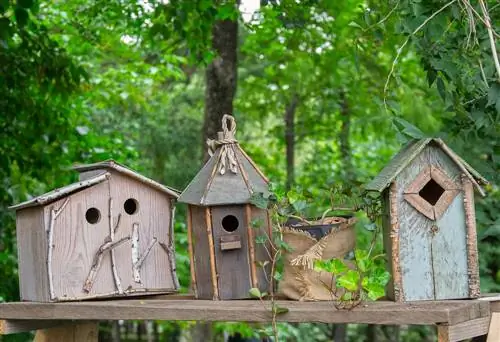
Only natural, untreated materials should be used when building nesting boxes
Use unplaned wooden boards from FSC-certified, sustainable forestry. The timber should be at least 18 mm thick. A rough wooden surface is an advantage so that the chicks inside can also cling to the side walls. Larch, oak and robinia wood promise the best durability. Softwoods such as pine, spruce and fir are cheaper and still acceptable. Chipboard or plywood are not weatherproof and therefore not suitable.
Screws are a better choice when building an excellent nesting box. By avoiding nails, you save yourself time-consuming gluing and construct a stable, long-lasting home for the feathered residents.
Chemical wood preservatives are taboo when building a he althy nursery for blackbirds, thrushes, finches and starlings. If you want to protect the birdhouse from fungal infestation and moisture, ideally paint the outer walls with organic linseed oil or a harmless paint with the “Blue Angel” environmental label.
Galvanized sheet steel is a good rain protection for the birdhouse roof. You can safely remove bitumen felt as a roof covering from the list of materials. Years of practice have proven that a nesting box will still get damp in this case. Quick drying indoors is often hindered by the cardboard.
Safety first
Three important precautions ensure additional security in the nesting box:
- Roof overhang: maximum possible overhang of the roof over the entrance hole so that predators cannot reach in from above
- Distance from the bottom edge of the hole to the ground: at least 17 cm distance as protection against greedy marten and cat paws
- no perch: without a perch, cats, martens and other predators cannot find a foothold
If the nesting box is not intended for a family of woodpeckers, you can protect the entry hole from brazen marauders in feathers. To do this, install a galvanized steel safety plate using screws. Thanks to this precaution, a hammering beak can't simply enlarge the opening, evict the current tenants, and annex the birdhouse. You can buy robust safety covers that match the hole size cheaply as accessories or spare parts from specialist retailers, for example at nistkasten-online.de for an economical 3 euros complete with 4 screws.
Hang up the nesting box professionally
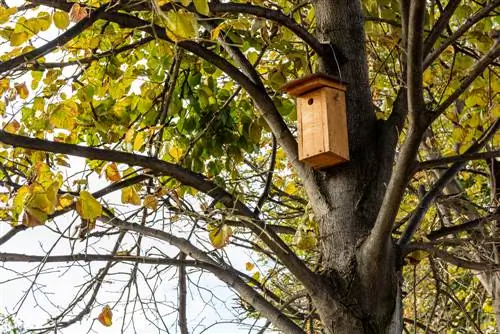
A nesting box should hang high enough and, if possible, face east or southeast
A homemade nesting box will be a hit in the bird world if you take the following aspects into account when hanging it up:
- Orientation: the entrance hole should face east or southeast, under no circumstances to the weather side to the west
- Tree-friendly attachment: attach to trees with covered wire and stainless screws
- Hanging direction: Hang the nesting box with a slight transition to the front so that rain can run off easily
- Time: the best date is in autumn because nesting aids are ideal winter quarters for birds, insects and small mammals
A minimum distance of 10 meters is recommended for nesting boxes of the same design. This ensures that the breeding bird species finds enough food for itself and its insatiable offspring. An exception applies to colony breeders, such as sparrows and starlings, who like to look after the chicks in close proximity. Nesting aids with entrance holes of different sizes should be at least 3 meters apart.
Special case of half-cave box
Because the semi-cave nesting box uses a wide gap instead of a narrow entry opening, trees are not suitable as a hanging location. Nesting boxes for blackbirds, wrens and robins are ideally placed on facades, on the balcony, on the shed or garden shed. Here cats and martens find few starting points to attack the young bird family.
Frequently asked questions
How big should the entry hole in the nesting box be for a budgie?
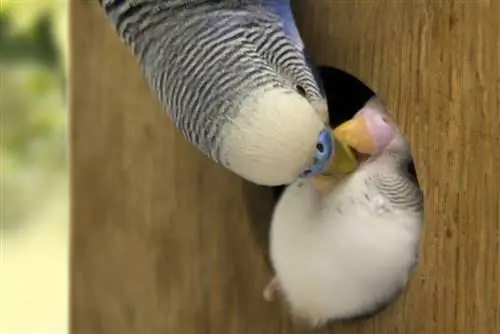
Nesting boxes for budgies should have a hole size of approx. 4cm
For a normal-sized pair of budgie parents, a hole size of 35-40 mm is suitable for the nesting box. If the two expectant parents are well fed, the diameter of the entry hole can be increased to 50-55 mm.
As a hobby gardener, I have a green thumb, but two left hands when it comes to DIY crafts. Where can I buy a ready-made nesting box for tits with the right hole size?
A good source for purchasing decorative tit nesting boxes is the NABU shop (€26.00 on Amazon). From just 12.99 euros you can purchase a species-appropriate nesting aid made of FSC wood for blue tits and their own species. Product selection based on entrance hole size is practical. If you only want to grant access to the slightly larger great tit, simply choose a nesting box with a hole size of 32 mm, which is even cheaper as a birch nesting aid at 7.99 euros.
How can you hang nesting boxes in the most tree-friendly way possible?
For nesting boxes for small bird species such as tits or sparrows, use a covered wire that does not cut into the tree bark when hanging. If it is a large nesting box for starlings, we recommend using a disused garden hose as additional casing. Cut a binding wire and old water hose to the correct length, with the binding wire sticking out a bit at both ends. A screw eyelet on each side wall of the nesting box serves as a holder for the wire, the ends of which you twist tightly.
Can a nesting box hang freely or should I mount it firmly?
Both variants are possible. However, it is important to remember that a nesting box with young birds should not be a swing. Busy bird parents will appreciate a less mobile nursery so that every feeding of the hungry beaks doesn't turn into a balancing act. There is also a risk that unsteady chicks will fall out more quickly from a dangling nest box.
Tip
Amateur gardeners who create and design their garden close to nature can be particularly happy about a fully utilized nesting box. Where native flowering bushes put on a magnificent display and pesticides are frowned upon, the table is richly set with nutritious berries, insects, maggots and larvae for growling bird bellies. If bird cherry (Prunus avium), hawthorn (Crataegus) or black elderberry (Sambucus nigra) thrive in the garden, every bird house is in great demand as the perfect refuge for starting a family.

